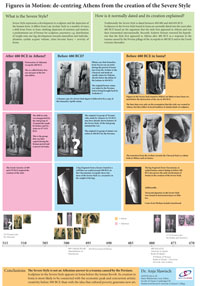Figures in Motion: de-centring Athens from the creation of the ‘Severe Style’
The general perception of the economic and cultural success of Ionia in Archaic and Hellenistic times is well supported by substantial epigraphic and archaeological evidence. This is starkly confronted, however, by our lack of knowledge and understanding of the Classical period.
It is well known that the Ionian cities were conquered by the Persians in 546/5 BCE which led, among other things, to the obligation to pay levies to and provide soldiers for the Persian state. Researchers of ancient history have argued extensively whether or not the outbreak of the Ionian revolt in 498 BCE can be attributed to an economic decline of Ionia under the Persian reign [and high taxation]. However, it seems certain, at least, that the Ionian revolt, and in particular the defeat of the Ionian cities in 494 BCE, marked a decisive event for everyday life, cult worship and political- and administrative organization in the entire region. Therefore two general questions arise:
- How can we use the meagre archaeological evidence to understand the consequences of the Ionian Revolt, the extent of ‘continuity’ in the Ionian landscape and therefore the dual physical and psychological processes of urban destruction and renewal in the ancient world?
- To what extent are archaeological categories prejudiced by the Atheno-centric lens of surviving historical sources, and can a close examination of the archaeological data from Ionia lead us to alternative reconstructions of Aegean artistic, political and economic history?
Both the Ionian revolt and the later victory of the Milesians at the battle of Mykale in 479 BCE have often formed the basis for the dating of sculptural evidence. The historical events have been used to characterise particular material as either the last exponents of Archaic prosperity, or else the proof for a quick resettlement after liberty.
Similarly, it is at about the same time that the transition from the Archaic to the Classical style is attributed. The end of the old period and the beginning of the new is generally dated around 480 BCE when the Persians sacked and burned down the Athenian Acropolis. Traditionally in art history, the suggestion has been that the new Classical style was invented by Athenian artists after the Persian invasion, and as a response to the trauma caused. Doubts about this interpretation have been common, particularly after J. M. Hurwits showed that the context of the Kritios Boy and the so-called Blond Head could not be described as safe and thus could not be taken as fixed points, or as the first representatives of a new tradition[1]. In a number of articles Andrew Stewart re-dates the beginning of the Classical Style down to 477/6 BC suggesting that the 2nd group of Tyrannicides, those by Kritios and Nesiotes, inaugurated the shift in style, and that the Greek victories of 480 and 479 BCE somehow inspired it[2].
For our purposes the dating of the earliest Classical Sculpture, the so-called “Severe Style”, is of considerable importance because of three sculptures found in Miletos that have been interpreted on stylistic grounds as examples of Early Classical sculpture, and therefore suggested as having been made immediately after 479 BCE when Miletos was freed from the Persians. Given the questions of continuity or disruption in the region, it is very important to know whether monumental sculptures of such high quality were made before or after the Ionian revolt, in order to place the whole 5th century in context.
A starting point for exploring this question is an article published in 2002 by V. M. Strocka on the statue of Apollon Didymeus, a monumental sculpture made by Kanachos, and through which the dating of the beginning of the Severe Style in Greek sculpture may be foregrounded[3]. This sculpture is known only from written sources, and as K. Tuchelt aptly quipped “Sie verdankt ihren Ruhm ihrem Schicksal” -This work owes its fame to its curious biography: originally manufactured for the Didymaion by a famous bronze caster from the Peloponnese, Kanachos from Sikyon, it was robbed by the Persians and given back to the Milesians by Seleukos I. Nicator. Based on the notes of Herodotos, the plunder and pillage of the sanctuary of Apollon Didymeus and with it the robbery of the Kanachos-Apollon is generally dated to the year 494 BCE, a date which gives us at the same time a terminus ante quem for the deposition of the statue into the sanctuary at Didyma/Branchidai.
Beside these examples, Ionia offers a number of original sculptures, terracottas and coins, which are – on stylistical grounds – assigned to the ‘Severe Style’. It is the aim of the paper to present an overview over the existing material by discussing not only their dating but also their importance for the wider question of the artistic development during the late 6th and the first half of the 5th century BCE.
The re-assessment of the dating of the Ionian evidence makes a strong case for the idea that both technical skills and the knowledge of the human body necessary to create the Severe Style were developed independently and primarily in Ionia and not, as is conventionally argued, in Athens.

[1] J. M. Hurwit, The Kritios Boy: Discovery, Reconstruction, and Date, AJA 93, 1989, 41–80.
[2] A. Stewart, The Persian and Carthagian Invasion of 480 B.C.E. and the Beginning of the Classical Style: Part 1, The Stratigraphy, Chronology, and Significance of the Acropolis Deposit; Part 2, The Finds from Other Sites in Athens, Attica, Elsewhere in Greece, and on Sicily; Part 3, The Severe Style: Motivations and Meaning, AJA 112, 2008, 377–412. 581–615.
[3] V. M. Strocka, Der Apollon des Kanachos in Didyma und der Beginn des Strengen Stils, JdI 117, 2002, 81–125.
Presented at: Ex Ionia Scientia – ‘Knowledge’ in Archaic Greece; International Conference, 12th to 14th December 2016; Athens
http://enlightenedionia.siu.edu/

